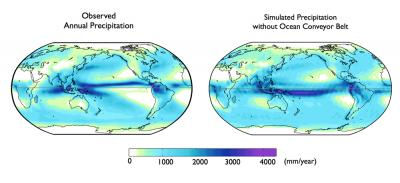20 October 2013
Ocean currents explain rainfall riddle
by Will Parker

Most of the rain on Earth falls in the Northern Hemisphere and scientists have long believed that this was a quirk of the planet's geometry, but a new University of Washington study shows that this rainfall pattern arises from a much simpler system.
"It rains more in the Northern Hemisphere because it's warmer," said atmosphere scientist Dargan Frierson. "The question is: What makes the Northern Hemisphere warmer? And we've found that it's the ocean circulation."
Frierson and his co-researchers first used measurements from NASA's Clouds and Earth's Radiant Energy System satellites to show that sunlight actually provides more heat to the Southern Hemisphere - and so, by atmospheric radiation alone, the Southern Hemisphere should be the soggier one.
After using other observations to calculate the ocean heat transport, the scientists next used computer models to show the key role of the huge conveyor-belt current that sinks near Greenland, travels along the ocean bottom to Antarctica, and then rises and flows north along the surface.
Eliminating this current flips the tropical rain bands to the south.
The reason, Frierson explains, is that as the water moves north over many decades it gradually heats up, carrying some 400 trillion watts of power across the equator.
For many years, slanting ocean basins have been the accepted reason for the asymmetry in tropical rainfall. "But at the same time, a lot of people didn't really believe that explanation because it's kind of a complicated argument. For such a major feature there's usually a simpler explanation," Frierson said.
The ocean current responsible was made famous in the movie The Day After Tomorrow, in which the premise was that the overturning circulation shut down and New York froze over. While a sudden shutdown like in the movie won't happen, a gradual slowing - which the recent United Nations report said was "very likely" by 2100 - could shift tropical rains south, the study suggests.
Related:
Discuss this article in our forum
Climatologists estimate extreme rainfall events in tropics
Oz rains soak up sea level rise
Sea-level rise predictions may be missing critical factors
Global warming getting El Niño all hot and bothered
